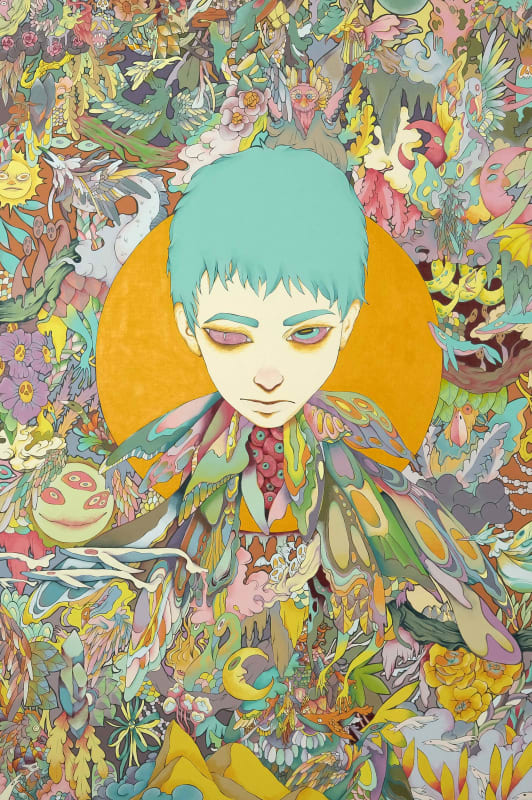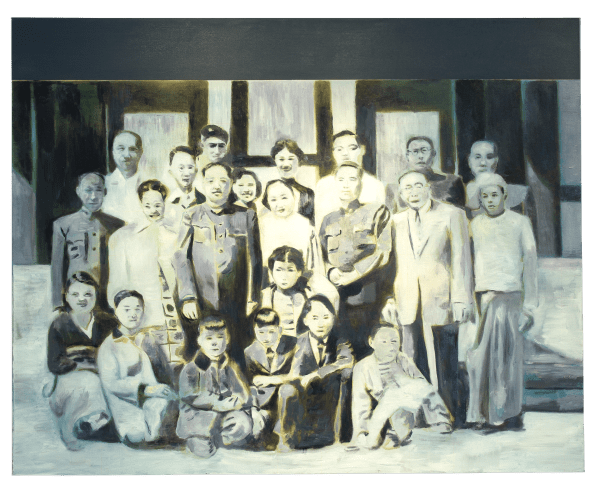En Route: Southeast Asia: Hilmi Johandi, Zai Kuning, Atreyu Moniaga, Soe Yu Nwe, Santi Wangchuan, Sawangwongse Yawnghwe
Ota Fine Arts Singapore is delighted to present "En Route: Southeast Asia", an exhibition featuring artists from Indonesia, Myanmar, Singapore and Thailand. The exhibition hopes to provide a window into contemporary art from Southeast Asia, where ideas of mythology, cultural traditions, heritage, identity, and history are actively interrogated.
Sawangwongse Yawnghwe (b.1971, Burma) was born in Shan State, known today as Myanmar. His grandfather, Sao Shwe Thaik, was the first president of the Union of Burma. Yawnghwe spent much of his youth in Thailand, and subsequently escaped to Canada, after a failed assassination attempt on his father in 1985. Thereafter, Yawnghwe found refuge in Amsterdam, where he works quietly in much anonymity. The paintings "Day trip at Southeast Asian Peninsular Games, Rangoon, 1961" and "The Guests" reveal simultaneously, Yawnghwe's personal family history and the complex issues surrounding Myanmar's unsettling political history. Taking his cue from archival images from early mid-twentieth century Burma, and American artist, Barnett Newman, his paintings are composed of painted photographs that are branded with grey stripes. The ambiguous figures and the fuzzy quality of the image hint of decay; a decaying of the photographs, and also that of cultural heritage and nation. Intrinsic to Yawnghwe's works is a continuous mining of personal memories, familial ties and identity that are inextricably linked to his nation's history.
Similarly, Hilmi Johandi (b. 1987, Singapore) delves into the national archives as part of his research practice. In his Landscaped grounds series, Hilmi focuses on the idea of reinventing spaces, planes and forms of the referenced subject. The motifs are drawn from postcards of Singapore from the 1980s-90s and feature places of interest that carry particular visual styles from specific eras and social contexts. Spaces in the paintings are broken up, partitioned, and collaged back together to create an uncanny world that is at once familiar yet foreign upon observation. His recent series, Destination image, introduces a closer and more intimate experience, depicting close-up, singular motifs. The subjects pursue ideas of pleasure and desire, and by scrutinizing these images, Hilmi delves into the core, questioning their superficial representations.
In contrast, Atreyu Moniaga's (b. 1987, Indonesia) paintings embody the fantasies of urban dwellers from a younger generation. Moniaga graduated with a degree in Communications and Visual Design from the Jakarta Institute of the Arts (IKJ), and now takes on multiple roles as artist, photographer, illustrator and actor. His otherworldly compositions reveal a whimsical universe of mystical creatures, ornamental plants, and spirited characters that one may associate with animation films. His most recent paintings, "Serendipity" and "Faux Nonchalant' are explorations into the medium of acrylic paint, and a fresh palette of pastel colours. The characters and creatures in his paintings express cheeky yet sinister expressions, exposing a complex layering of various emotions such as fear, anxiety, joy and calmness, which the artist experienced in the process of making these new works.
Using ceramics as a key medium, Soe Yu Nwe (b. 1989, Myanmar) explores the cycles in mother nature and, Myanmar's heritage and spiritual traditions. A primary and recurring motif in Soe's work is the serpent. This interest originates from her explorations for a self-symbol, and the serpent being her Chinese Zodiac sign. In much of Asian mythology, the serpent is associated with regeneration, shape shifting, fertility and feminine prowess. Yet Soe's sculptures also reveal creatures plagued with fragmented edges, thorns and a certain fragility, offering us some visibility into Soe's experience growing up in a conservative society, and her longing for wholeness in her multicultural and incomplete identity formation.
Santi Wangchuan (b. 1988, Thailand) recalls and revitalizes the handweaving traditions of the Ubon Ratchathani province located in Northeast Thailand. Wangchuan learned how to weave from his grandmother and mother at a young age, and after studying art history, he sought to re-engage the traditional craft that is gradually disappearing with rapid urbanisation. His works are interwoven with collective memories, folk stories, religious practices and objects that are native to his hometown. Closer examinations of his sculptures, "Weaving of Memorable Space (No.5)" and "Weaving of Memorable Space (No.9)", reveal the presence of fishing baskets and antique weaving tools, reminding its audience of an old way of life in Thailand and the larger Southeast Asia.
For nearly two decades, Zai Kuning (b. 1964, Singapore) has been working with indigenous groups of people, namely the Orang Laut and Orang Asli, and has created bodies of works inspired by his research and interactions with them. The Orang Asli communities are the indigenous population of the Malaysia Peninsula. Zai became particularly interested in the work of the Mah Meri people, specifically the craftsmanship of masks and statues. The ancient imaginations of facial and bodily expressions are represented in these forms. Zai's work "The Last Breath of Malaya" is inspired by the 18 ethnic groups of the Orang Asli that are officially recognised by the Malaysian Government. Zai explores a form of imagination and an expression of the face, like what the Mah Meri people have been doing for centuries.
These Southeast Asian countries — from which these artists are from — are diverse, yet bounded together geographically and historically. Some of these areas are developed and cosmopolitan, while others are more in sync with their ancestral heritage and cultures. Ota Fine Arts Singapore hopes to offer visibility of the region's artists to our audiences, and to articulate some of the differentiated stories of Southeast Asia.
-
 Hilmi JohandiDestination Image #5 (Cascading Waterfalls), 2023Oil on linen130 x 90 cm
Hilmi JohandiDestination Image #5 (Cascading Waterfalls), 2023Oil on linen130 x 90 cm -
 Hilmi JohandiDestination Image #6 (A Whole New Asia), 2023Oil on linen130 x 160 cm
Hilmi JohandiDestination Image #6 (A Whole New Asia), 2023Oil on linen130 x 160 cm -
![Zai Kuning The Last Breath of Malaya, 2021 Acrylic on canvas 121.8 x 183 cm [18 panels, 40.6 x 30.5 cm each]](data:image/gif;base64,R0lGODlhAQABAIAAAAAAAP///yH5BAEAAAAALAAAAAABAAEAAAIBRAA7) Zai KuningThe Last Breath of Malaya, 2021Acrylic on canvas121.8 x 183 cm [18 panels, 40.6 x 30.5 cm each]
Zai KuningThe Last Breath of Malaya, 2021Acrylic on canvas121.8 x 183 cm [18 panels, 40.6 x 30.5 cm each] -
 Soe Yu NweUntitled Hand, 2018Glazed hand built and casted porcelain, 1260 C, gold and mother of pearl luster17 x 16 x 33 cm
Soe Yu NweUntitled Hand, 2018Glazed hand built and casted porcelain, 1260 C, gold and mother of pearl luster17 x 16 x 33 cm -
 Soe Yu NweNAGA MAEDAW, THE EYE, 2018Glazed hand built porcelain, slip-casted parts, 1300 C, gold and mother of pearl luster43.2 x 48.3 x 20.3 cm
Soe Yu NweNAGA MAEDAW, THE EYE, 2018Glazed hand built porcelain, slip-casted parts, 1300 C, gold and mother of pearl luster43.2 x 48.3 x 20.3 cm -
 Santi WangchuanBuddha Footprint, 2016Weaving, hand-dyed fibre, synthetic fibre, rope, thread230 x 150 x 40 cm
Santi WangchuanBuddha Footprint, 2016Weaving, hand-dyed fibre, synthetic fibre, rope, thread230 x 150 x 40 cm -
 Santi WangchuanWeaving of Memorable Space (No. 5), 2017Rope, thread, fibre, antique weaving tools and fishing baskets65 x 70 cm
Santi WangchuanWeaving of Memorable Space (No. 5), 2017Rope, thread, fibre, antique weaving tools and fishing baskets65 x 70 cm -
 Santi WangchuanWeaving of Memorable Space (No. 9), 2017Rope, thread, fibre, antique weaving tools and fishing baskets65 x 70 cm
Santi WangchuanWeaving of Memorable Space (No. 9), 2017Rope, thread, fibre, antique weaving tools and fishing baskets65 x 70 cm -
 Sawangwongse YawnghweDay trip at Southeast Asian Peninsular Games, Rangoon, 1961, 2022Acrylic on linen200 x 190 cm
Sawangwongse YawnghweDay trip at Southeast Asian Peninsular Games, Rangoon, 1961, 2022Acrylic on linen200 x 190 cm -
 Sawangwongse YawnghweThe Guests, 2022Oil on linen120 x 150 cm
Sawangwongse YawnghweThe Guests, 2022Oil on linen120 x 150 cm



![Zai Kuning The Last Breath of Malaya, 2021 Acrylic on canvas 121.8 x 183 cm [18 panels, 40.6 x 30.5 cm each]](https://artlogic-res.cloudinary.com/w_600,c_limit,f_auto,fl_lossy,q_auto/artlogicstorage/otafinearts/images/view/edd3ca848b1e7bc197240ed1b6088393j/otafinearts-zai-kuning-the-last-breath-of-malaya-2021.jpg)










